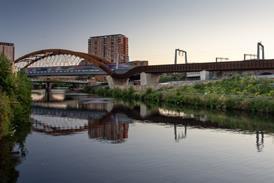Measuring and reducing our embodied carbon is still the best tool that we have to limit our impact on the planet, but it shouldn’t be the only factor that we’re considering, writes Anna Beckett

Towards the end of last year, the children’s toy manufacturer Lego announced that they had abandoned efforts to make their bricks out of recycled plastic bottles after research showed that the embodied carbon of the bricks would be higher than if they continued to manufacture them from ABS (acrylonitrile butadiene styrene) plastic. On the surface the decision seems to make a lot of sense; they had considered two alternatives and had selected the lower carbon option. And they were planning to continue research into bio-materials that the bricks could potentially be made from. That all seems very sensible.
Except that manufacturing Lego bricks from recycled bottles is helping to deal with a waste product that we have an abundance of - actually if we’re cleaning up the oceans at the same time then it becomes a regenerative process. And the biggest issue in terms of carbon was the upgrade in equipment required to make the bricks rather than the process itself. Plus, do we actually need any more Lego bricks at all? Surely there must be thousands of bricks already out there, forgotten in people’s attics or worse destined for landfill, that could be cleaned up and resold. Especially if the bricks are as hardwearing as Lego suggest (this is one of their current issues with bio-materials).
So is our focus on carbon stopping us from seeing the bigger picture? The position that Lego have found themselves in seems incredibly similar to the position we’ve found ourselves in with materials in the construction industry. We’ve learnt how to measure embodied carbon, we understand embodied carbon and we know that we need to reduce embodied carbon. But should that supersede every other environmental consideration for those materials? Or do we now need to take what we’ve learnt about carbon and apply that a little more holistically?
Measuring and reducing our embodied carbon is still the best tool that we have to limit our impact on the planet, but it shouldn’t be the only factor that we’re considering
We need to start to consider not just the embodied carbon of the materials we’re using, but where that material has come from, how it was extracted and what that extraction process might have done to the biodiversity of the area that it came from. We need to consider the water used in the manufacturing process and the waste products that the process might produce. And we need to consider whether those processes can be changed so that our impact on the environment is reduced, or better yet, so that our impact on the environment is actually positive.
The idea of regenerative design has started to be talked about more and more, and while it’s not the easiest subject to get your head around in practical terms, the idea that what we’re building could actively contribute to improving the environment (rather than just not doing any harm) certainly seems like something we should aspire to. Recent publications about both regenerative design and measuring biodiversity impacts have started to provide guidance for the industry but it will require a fundamental shift in the way that we work, and in the short term that shift might be difficult to deal with.
Measuring and reducing our embodied carbon is still the best tool that we have to limit our impact on the planet, but it shouldn’t be the only factor that we’re considering. And if we start to consider other factors then it’s inevitable that we will find conflicts, just as Lego have. But by taking a more holistic view of the impact we’re having we can find the right balance between limiting carbon and creating something that has a better outcome tomorrow than it had today.
Postscript
Anna Beckett is an associate at Buro Happold
















2 Readers' comments